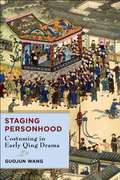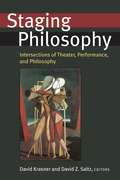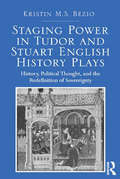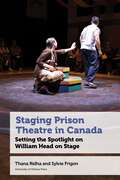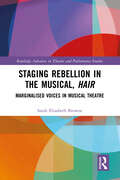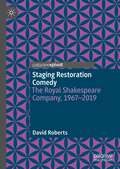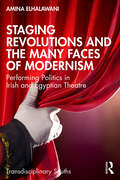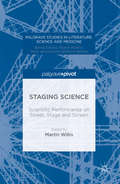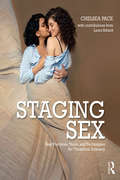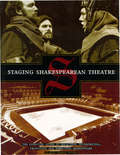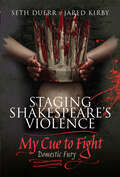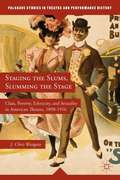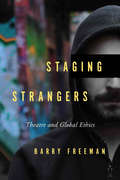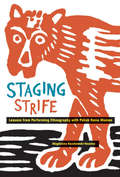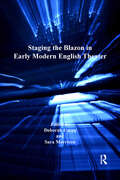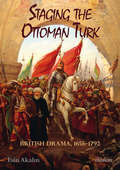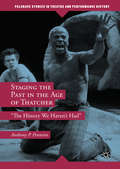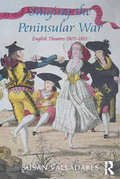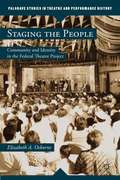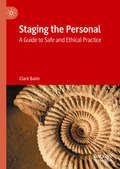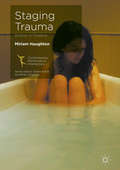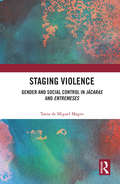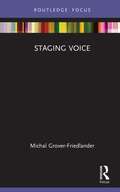- Table View
- List View
Staging Personhood: Costuming in Early Qing Drama
by Guojun WangAfter toppling the Ming dynasty, the Qing conquerors forced Han Chinese males to adopt Manchu hairstyle and clothing. Yet China’s new rulers tolerated the use of traditional Chinese attire in performances, making theater one of the only areas of life where Han garments could still be seen and where Manchu rule could be contested.Staging Personhood uncovers a hidden history of the Ming–Qing transition by exploring what it meant for the clothing of a deposed dynasty to survive onstage. Reading dramatic works against Qing sartorial regulations, Guojun Wang offers an interdisciplinary lens on the entanglements between Chinese drama and nascent Manchu rule in seventeenth-century China. He reveals not just how political and ethnic conflicts shaped theatrical costuming but also the ways costuming enabled different modes of identity negotiation during the dynastic transition. In case studies of theatrical texts and performances, Wang considers clothing and costumes as indices of changing ethnic and gender identities. He contends that theatrical costuming provided a productive way to reconnect bodies, clothes, and identities disrupted by political turmoil. Through careful attention to a variety of canonical and lesser-known plays, visual and performance records, and historical documents, Staging Personhood provides a pathbreaking perspective on the cultural dynamics of early Qing China.
Staging Philosophy: Intersections of Theater, Performance, and Philosophy
by David Krasner David Z. SaltzScholars of drama, philosophy, and literature apply insights from current philosophical theories to performance theory. Writing for non-specialists in the philosophy of performance, they consider such topics as critical realism and performance strategies, the ontology of presence reconsidered, and the Black arts movement and logo-centrism. Annotation ©2007 Book News, Inc. , Portland, OR (booknews. com)
Staging Power in Tudor and Stuart English History Plays: History, Political Thought, and the Redefinition of Sovereignty
by Kristin M.S. BezioStaging Power in Tudor and Stuart English History Plays examines the changing ideological conceptions of sovereignty and their on-stage representations in the public theaters during the Elizabethan and early Stuart periods (1580-1642). The study examines the way in which the early modern stage presented a critical dialogue concerning the nature of sovereignty through the lens of specifically English history, focusing in particular on the presentation and representation of monarchy. It presents the subgenre of the English history play as a specific reaction to the surrounding political context capable of engaging with and influencing popular and elite conceptions of monarchy and government. This project is the first of its kind to specifically situate the early modern debate on sovereignty within a 'popular culture' dramatic context; its purpose is not only to provide an historical timeline of English political theory pertaining to monarchy, but to situate the drama as a significant influence on the production and dissemination thereof during the Tudor and Stuart periods. Some of the plays considered here, notably those by Shakespeare and Marlowe, have been extensively and thoroughly studied. But others-such as Edmund Ironside, Sir Thomas Wyatt, and King John and Matilda-have not previously been the focus of much critical attention.
Staging Prison Theatre in Canada: Setting the Spotlight on William Head on Stage
by Mme Thana Ridha Professeure Sylvie FrigonFor over forty years, William Head on Stage (WHoS) has operated as an inmate-run prison theatre, making it one of Canada’s longest-standing prison arts initiatives.Staging Prison Theatre in Canada: Setting the Spotlight on William Head on Stage delves into the story of WHoS through the voices of the men involved, offering a unique criminological perspective that situates their experiences within the prison context.The analysis explores how WHoS creates an alternative space within the social and emotional realities of incarceration. By unlocking participants’ capacities, skills, and confidence, the initiative fosters a sense of agency and community both inside the prison and beyond. WHoS becomes a space for transformation, offering men opportunities to re-imagine themselves and build meaningful connections.This work underscores the broader significance of arts-based initiatives like WHoS, not only within prisons but also in the fields of criminology, theatre, and community engagement. It offers valuable insights for correctional administrators, criminologists, theatre practitioners, scholars, students, and anyone interested in the intersection of art and rehabilitation.
Staging Rebellion in the Musical, Hair: Marginalised Voices in Musical Theatre (Routledge Advances in Theatre & Performance Studies)
by Sarah Elisabeth BrowneThis volume provides a comprehensive survey of the musical Hair and will offer critical analysis which focuses on giving voice to those who are historically considered to be on the margins of musical theatre history. Sarah Browne interrogates key scenes from the musical which will seek to identify the relationship between performance and the cultural moment. Whilst it is widely acknowledged that Hair is a product of the sixties counter-culture, this study will place the analysis in its socio-historical context to specifically reveal American values towards race, gender, and adolescence. In arguing that Hair is a rebellion against the established normative values of both American society and the art form of the musical itself, this book will suggest ways in which Hair can be considered utopian: not only as a utopian ‘text’ but in the practices and values it embodies, and the emotions it generates in its audiences. This book will be of great interest to scholars and students of music, musical theatre, popular music, American studies, film studies, gender studies, or African American studies.
Staging Restoration Comedy: The Royal Shakespeare Company, 1967-2019
by David RobertsSince its 1967 production of Vanbrugh’s The Relapse, the Royal Shakespeare Company has been the world’s leading producer of Restoration Comedies. This book is the first to document and critique the company’s history of engagement with that repertoire. It reviews the spaces in which productions have been performed, design principles, casting, voicing, textual adaptation, musical direction, actor perspectives, and the problems of how to confront, adopt or depart from received notions of Restoration style. It goes on to posit that, for all the RSC’s explorations of Restoration Comedy, the company has maintained the repertoire as a fringe interest played out in niche spaces, while recycling many of the assumptions it claims to challenge, and that what is needed is the writer-led intervention seen in RSC and National Theatre adaptations of French drama from the same period. Only then can Restoration Comedy begin to engage wider audiences in new sites of political, historical andcultural meaning.
Staging Revolutions and the Many Faces of Modernism: Performing Politics in Irish and Egyptian Theatre (Transdisciplinary Souths)
by Amina ElHalawaniThe book explores how theatre, with its performative capacity, has the power to engage with and affect the politics of its day. It sets the stage for the reader to discover the revolutionary traditions of Egyptian and Irish theatre, very distinct in their histories and cultures, and understand their enduring relevance in today’s world. The volume takes Ireland as a case study of the interplay between cultural nationalism and politically engaged theatre and compares it to the role of the theatre in Egypt during its Golden era in the 1960s.Through a selection of Egyptian plays by Tawfiq al-Hakim, Mikhail Roman, Yusuf Idris, and Salah Abdul-Saboor, alongside Irish plays by Brian Friel, Frank McGuinness, Christina Reid, and Samuel Beckett, it maps the political aesthetics of unsteady times and seemingly disparate places to reflect on the dynamics of revolt as a staged act in and of itself. Further, the book examines how playwrights from both nations have engaged with theatre as a medium, focusing on how their contemplations, hesitations, frustrations, and protest have been translated onto the stage in their various plays, and comprehends the transformative role the theatre has always played in politics in shaping history across time and space.Bridging together discussions on transnational modernisms with nuanced cultural histories of protest, this critical work will be of great interest to scholars and researchers of literary studies, identity politics, cultural studies, theatre and performance studies, and political studies.
Staging Science: Scientific Performance on Street, Stage and Screen (Palgrave Studies in Literature, Science and Medicine)
by Martin WillisThis book considers scientific performances across two centuries, from the early nineteenth century to the present day. Performances include demonstrations of technologies, experiments that look like theatre, theatre that looks like science, tourist representations and natural history film-making. Its key aim is to open debate on how scientific activity, both historical and contemporary, might be understood in the context of performance studies and the imaginative acts required to stage engaging performances.Scientific performances have become increasingly of interest to historians of science, literature and science scholars, and in the field of science studies. As yet, however, no work has sought to examine a range of scientific performances with the aim of interrogating and illuminating the kinds of critical and theoretical practices that might be employed to engage with them. With scientific performance likely to become ever more central to scholarly study in the next few years this volume offer a timely, and early, intervention in the existing debates, and aims, too, to be a touchstone for future work.
Staging Sex: Best Practices, Tools, and Techniques for Theatrical Intimacy
by Chelsea PaceStaging Sex lays out a comprehensive, practical solution for staging intimacy, nudity, and sexual violence. This book takes theatre practitioners step-by-step through the best practices, tools, and techniques for crafting effective theatrical intimacy. After an overview of the challenges directors face when staging theatrical intimacy, Staging Sex offers practical solutions and exercises, provides a system for establishing and discussing boundaries, and suggests efficient and effective language for staging intimacy and sexual violence. It also addresses production and classroom specific concerns and provides guidance for creating a culture of consent in any company or department. Written for directors, choreographers, movement coaches, stage managers, production managers, professional actors, and students of acting courses, Staging Sex is an essential tool for theatre practitioners who encounter theatrical intimacy or instructional touch, whether in rehearsal or in the classroom.
Staging Shakespearean Theatre: The Essential Guide to Selecting, Interpreting, Producing and Directing Shakespe are
by Elaine NovakFrom auditions and rehearsals to publicity, this guide leads even inexperienced directors, producers, choreographers and actors through the complicated and sometimes fearsome task of staking Shakespeare. Comprehensive information is presented in a browsable format including historical background of the Elizabeth period, descriptions of major plays, a glossary of terms, suggestions for modern interpretations, step-by-step instruction for choreographing fight scenes, and a full treatment of Romeo & Juliet
Staging Shakespeare's Violence: My Cue to Fight, Domestic Fury
by Seth DuerrThis is the first book of its kind to provide an in-depth examination of how the greatest playwright in the English language employed not only psychological brutality but also physical violence throughout his works.My Cue to Fight is the first book of its kind to provide an in-depth examination of how the greatest playwright in the English language employed not only psychological brutality but also physical violence throughout his works. Written ideally for theatrical stage directors, fight directors, intimacy consultants, and actors as a technical scene-by-scene breakdown in staging combat during production of these plays, this publication is also for Shakespeare enthusiasts who want to learn more about the blood, sweat, and viscera hidden just underneath the poetry. A writer utilizes violence, like song or dance, in moments where the story requires more than just words. But addressing how the violence will be staged tends either to be neglected or utterly gratuitous, both of which serve to separate the audience from the story and kill the whole venture. The answer rests in approaching violence the same way we do scenework. The plays of William Shakespeare seek to engage audiences with all of the characters’ blood, tears, sweat, and guts. These works are not flowery poems meant to be mumbled in a classroom, or histrionically declaimed in frilly costumes. There is nothing light and fluffy about 'rape' and 'murder’s rages', or 'carving' someone as a dish fit for the gods, or fighting till from one’s bones one’s 'flesh be hacked'. Making matters more complicated is the ambiguity and sometimes even complete lack of stage directions. Modern texts typically possess clear directions whenever violence is to occur in the action, but playscripts were quite different four centuries ago. Such denotations were both rare and inconsistent in Elizabethan and Jacobean printings. The potential violence we will examine is not appropriate for all productions or scene partners. We’re here to question and inspire rather than provide catch-all solutions. Actors, directors, fight directors, and intimacy consultants must work together to find the most effective way for their production to communicate the playwright’s story to the audience.
Staging The Slums, Slumming The Stage
by J. Chris WestgateDrawing on traditional archival research, reception theory, cultural histories of slumming, and recent work in critical theory on literary representations of poverty, Westgate argues that the productions of slum plays served as enactments of the emergent definitions of the slum and the corresponding ethical obligations involved therein.
Staging Strangers: Theatre and Global Ethics
by Barry FreemanTwenty-first-century media and political discourse sometimes makes "strangers" - refugees, immigrants, minorities - the scapegoats for social and economic disorder. In this heated climate, theatre has the potential to promote greater compassion and empathy for outsiders. A study of cultural difference in contemporary Canadian theatre, Staging Strangers considers how theatre facilitates an understanding of distant places and issues. Theatre in Canada, and especially in Toronto, has long been a place for communities to celebrate their traditions, but it is now emerging as a forum for staging stories that stretch beyond the local and the national. Combining archival research and performance analysis, Barry Freeman analyzes the possibilities and hazards of representing strangers, and the many ways the stranger on stage may be fetishized or domesticated, marked for assimilation, or turned into an object of fear. A fresh look at ways to cultivate ethical responsibility for global issues, Staging Strangers imagines a role for theatre in creating a more tolerant, caring, and cooperative world.
Staging Strangers: Theatre and Global Ethics
by Barry FreemanTwenty-first-century media and political discourse sometimes makes "strangers" - refugees, immigrants, minorities - the scapegoats for social and economic disorder. In this heated climate, theatre has the potential to promote greater compassion and empathy for outsiders. A study of cultural difference in contemporary Canadian theatre, Staging Strangers considers how theatre facilitates an understanding of distant places and issues. Theatre in Canada, and especially in Toronto, has long been a place for communities to celebrate their traditions, but it is now emerging as a forum for staging stories that stretch beyond the local and the national. Combining archival research and performance analysis, Barry Freeman analyzes the possibilities and hazards of representing strangers, and the many ways the stranger on stage may be fetishized or domesticated, marked for assimilation, or turned into an object of fear. A fresh look at ways to cultivate ethical responsibility for global issues, Staging Strangers imagines a role for theatre in creating a more tolerant, caring, and cooperative world.
Staging Strife
by Magdalena Kazubowski-HoustonConcerned with traditional power imbalances between researchers and participants, contemporary social science has begun using collaborative research as an empowering methodology that involves participants in key decisions. Collaborative research is a potentially revolutionary method for studying people and their cultures, but does it work in practice? Staging Strife looks at the limits of this methodology by examining a politically charged theatre performance undertaken with a group of Roma women in Poland. Magdalena Kazubowski-Houston describes a production she co-wrote and co-directed using collaborative methods. She had hoped this would result in more equitable research and raise community awareness about the violence and racism Roma women face. Instead, she found herself embroiled in ethically questionable power games in order to salvage the production. Staging Strife is the result of a painful re-examination of the experience, her motives as a researcher, and a long-overdue critique of collaborative research. Disarmingly honest, this exploration of innovative theatre techniques and social science methodologies will lead anthropologists to rethink the ways in which they work.
Staging Strife: Lessons from Performing Ethnography with Polish Roma Women (ISSN)
by Magdalena Kazubowski-HoustonConcerned with traditional power imbalances between researchers and participants, contemporary social science has begun using collaborative research as an empowering methodology that involves participants in key decisions. Collaborative research is a potentially revolutionary method for studying people and their cultures, but does it work in practice? Staging Strife looks at the limits of this methodology by examining a politically charged theatre performance undertaken with a group of Roma women in Poland.
Staging the Blazon in Early Modern English Theater (Studies In Performance And Early Modern Drama)
by Sara Morrison Deborah UmanOffering the first sustained and comprehensive scholarly consideration of the dramatic potential of the blazon, this volume complicates what has become a standard reading of the Petrarchan convention of dismembering the beloved through poetic description. At the same time, it contributes to a growing understanding of the relationship between the material conditions of theater and interpretations of plays by Shakespeare and his contemporaries. The chapters in this collection are organized into five thematic parts emphasizing the conventions of theater that compel us to consider bodies as both literally present and figuratively represented through languge. The first part addresses the dramatic blazon as used within the conventions of courtly love. Examining the classical roots of the Petrarchan blazon, the next part explores the violent eroticism of a poetic technique rooted in Ovidian notions of metamorphosis. With similar attention paid to brutality, the third part analyzes the representation of blazonic dismemberment on stage and screen. Figurative battles become real in the fourth part, which addresses the frequent blazons surfacing in historical and political plays. The final part moves to the role of audience, analyzing the role of the observer in containing the identity of the blazoned woman as well as her attempts to resist becoming an objectified spectacle.
Staging the Ottoman Turk: British Drama, 1656–1792
by Esin AkalınIn the wake of the fear that gripped Europe after the fall of Constantinople in 1453, English dramatists, like their continental counterparts, began representing the Ottoman Turks in plays inspired by historical events. The Ottoman milieu as a dramatic setting provided English audiences with a common experience of fascination and fear of the Other. The stereotyping of the Turks in these plays—revolving around complex themes such as tyranny, captivity, war, and conquests—arose from their perception of Islam. The Ottomans' failure in the second siege of Vienna in 1683 led to the reversal of trends in the representation of the Turks on stage. As the ascending strength of a web of European alliances began to check Ottoman expansion, what then began to dazzle the aesthetic imagination of eighteenth century England was the sultan's seraglio with images of extravaganza and decadence. In this book, Esin Akalin draws upon a selective range of seventeenth and eighteenth century plays to reach an understanding, both from a non-European perspective and Western standpoint, how one culture represents the other through discourse, historiography, and drama. The book explores a cluster of issues revolving around identity and difference in terms of history, ideology, and the politics of representation. In contextualizing political, cultural, and intellectual roots in the ideology of representing the Ottoman/Muslim as the West's Other, the author tackles with the questions of how history serves literature and to what extent literature creates history.
Staging the Past in the Age of Thatcher: The History We Haven't Had (Palgrave Studies In Theatre And Performance History Ser.)
by Anthony P. PenninoThis book investigates how the British theatrical community offered an alternative and oppositional historical narrative to the heritage culture promulgated by the Thatcher and Major Governments in the 1980s and early 1990s. It details the challenges the theatre faced, especially reductions in government funding, and examines seminal playwrights of the period – including but not limited to Caryl Churchill, Howard Brenton, Sarah Daniels, David Edgar, and Brian Friel – who dramatized a more inclusive vision of history that gave voice to traditionally marginalized communities. It employs James Baldwin’s concept of witnessing as the means by which history could be deployed to articulate an alternative and emergent political narrative: “the history we haven’t had”. This book will appeal to students and scholars of theatre and cultural studies as well as theatre practitioners and enthusiasts.
Staging the Peninsular War: English Theatres 1807-1815
by Susan ValladaresFrom Napoleon's invasion of Portugal in 1807 to his final defeat at Waterloo, the English theatres played a crucial role in the mediation of the Peninsular campaign. In the first in-depth study of English theatre during the Peninsular War, Susan Valladares contextualizes the theatrical treatment of the war within the larger political and ideological axes of Romantic performance. Exploring the role of spectacle in the mediation of war and the links between theatrical productions and print culture, she argues that the popularity of theatre-going and the improvisation and topicality unique to dramatic performance make the theatre an ideal lens for studying the construction of the Peninsular War in the public domain. Without simplifying the complex issues involved in the study of citizenship, communal identities, and ideological investments, Valladares recovers a wartime theatre that helped celebrate military engagements, reform political sympathies, and register the public’s complex relationship with Britain’s military campaign in the Iberian Peninsula. From its nuanced reading of Richard Brinsley Sheridan's Pizarro (1799), to its accounts of wartime productions of Shakespeare, description of performances at the minor theatres, and detailed case study of dramatic culture in Bristol, Valladares’s book reveals how theatrical entertainments reflected and helped shape public feeling on the Peninsular campaign.
Staging the People
by Elizabeth A. OsborneThe Federal Theatre Project stands alone as the only national theatre in the history of the United States. This study re-imagines this vital moment in American history, considering the Federal Theatre Project on its own terms - as a "federation of theatres" designed to stimulate new audiences and create locally-relevant theatre during the turbulent 1930s. It integrates a wealth of previously undiscovered archival materials with cultural history, delving into regional activities in Chicago, Boston, Portland, Atlanta, and Birmingham, as well as tours of refugee camps and Civilian Conservation Corps Divisions. For a brief, exhilarating moment, the Federal Theatre Project created a democratic theatre that staged the American people.
Staging the Personal: A Guide to Safe and Ethical Practice
by Clark BaimThis book examines the history, ethics, and intentions of staging personal stories and offers theatre makers detailed guidance and a practical model to support safe, ethical practice. Contemporary theatre has crossed boldly into therapeutic terrain and is now the site of radical self-exposure. Performances that would once have seemed shockingly personal and exposing have become commonplace, as people reveal their personal stories to audiences with ever-increasing candor. This has prompted the need for a robust and pragmatic framework for safe, ethical practice in mainstream and applied theatre. In order to promote a wider range of ethical risk-taking where practitioners negotiate blurred boundaries in safe and artistically creative ways, this book draws on relevant theory and practice from theatre and performance studies, psychodrama and attachment narrative therapy and provides detailed guidance supporting best practice in the theatre of personal stories. The guidance is structured within a four-part framework focused on history, ethics, praxis, and intentions. This includes a newly developed model for safe practice, called the Drama Spiral.The book is for theatre makers in mainstream and applied theatre, educators, students, researchers, drama therapists, psychodramatists, autobiographical performers, and the people who support them.
Staging Trauma: Bodies In Shadow (Contemporary Performance Interactions )
by Miriam HaughtonThis book investigates contemporary British and Irish performances that stage traumatic narratives, histories, acts and encounters. It includes a range of case studies that consider the performative, cultural and political contexts for the staging and reception of sexual violence, terminal illness, environmental damage, institutionalisation and asylum. In particular, it focuses on 'bodies in shadow' in twenty-first century performance: those who are largely written out of or marginalised in dominant twentieth-century patriarchal canons of theatre and history. This volume speaks to students, scholars and artists working within contemporary theatre and performance, Irish and British studies, memory and trauma studies, feminisms, performance studies, affect and reception studies, as well as the medical humanities.
Staging Violence: Gender and Social Control in Jácaras and Entremeses
by Tania de Miguel MagroStaging Violence explores gender violence in Spanish early modern short theater. This book deals with domestic violence against women, extortion of prostitutes, and violence against men who display non-conventional forms of masculinity. The author argues that many "jácaras" and "entremeses" stage subversive discourses that repudiate or complicate official narratives of gender and the use of violence as a tool for achieving gender compliance. Short comic pieces are read against comedias. Each section of the book is expertly contextualized through an overview of the legal and moral contexts and the analysis of a variety of primary sources (law codes, manuals of conduct, church rulings, transcripts of civil and religious trials, and medical manuals) as well as statistical information. Staging Violence invites the reader to consider the transgressive potential of performance. As the first monograph entirely dedicated to the study of gender in this genre, this book is a vital resource for students and scholars interested in gender studies and theatre.
Staging Voice (Routledge Voice Studies)
by Michal Grover-FriedlanderStaging Voice is a unique approach to the aesthetics of voice and its staging in performance. This study reflects on what it would mean to take opera’s decisive attribute—voice—as the foundation of its staged performance. The book thinks of staging through the medium of voice. It is a nuances exploration, which brings together scholarly and directorial interpretations, and engages in detail with less frequently performed works of major and influential 20th-century artists—Erik Satie, Bertolt Brecht and Kurt Weill—as well as exposes readers to an innovative experimental work of Evelyn Ficarra and Valerie Whittington. The study is intertwined throughout with the author’s staging of the works accessible online. This book will be of great interest to students and scholars in voice studies, opera, music theatre, musicology, directing, performance studies, practice-based research, theatre, visual art, stage design, and cultural studies.
